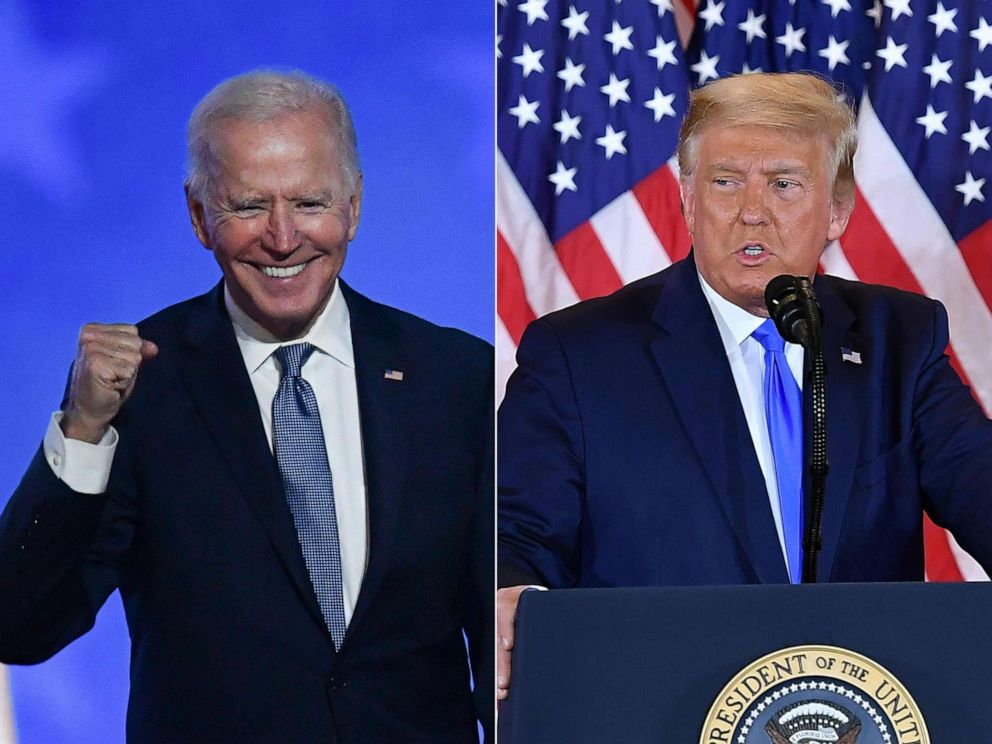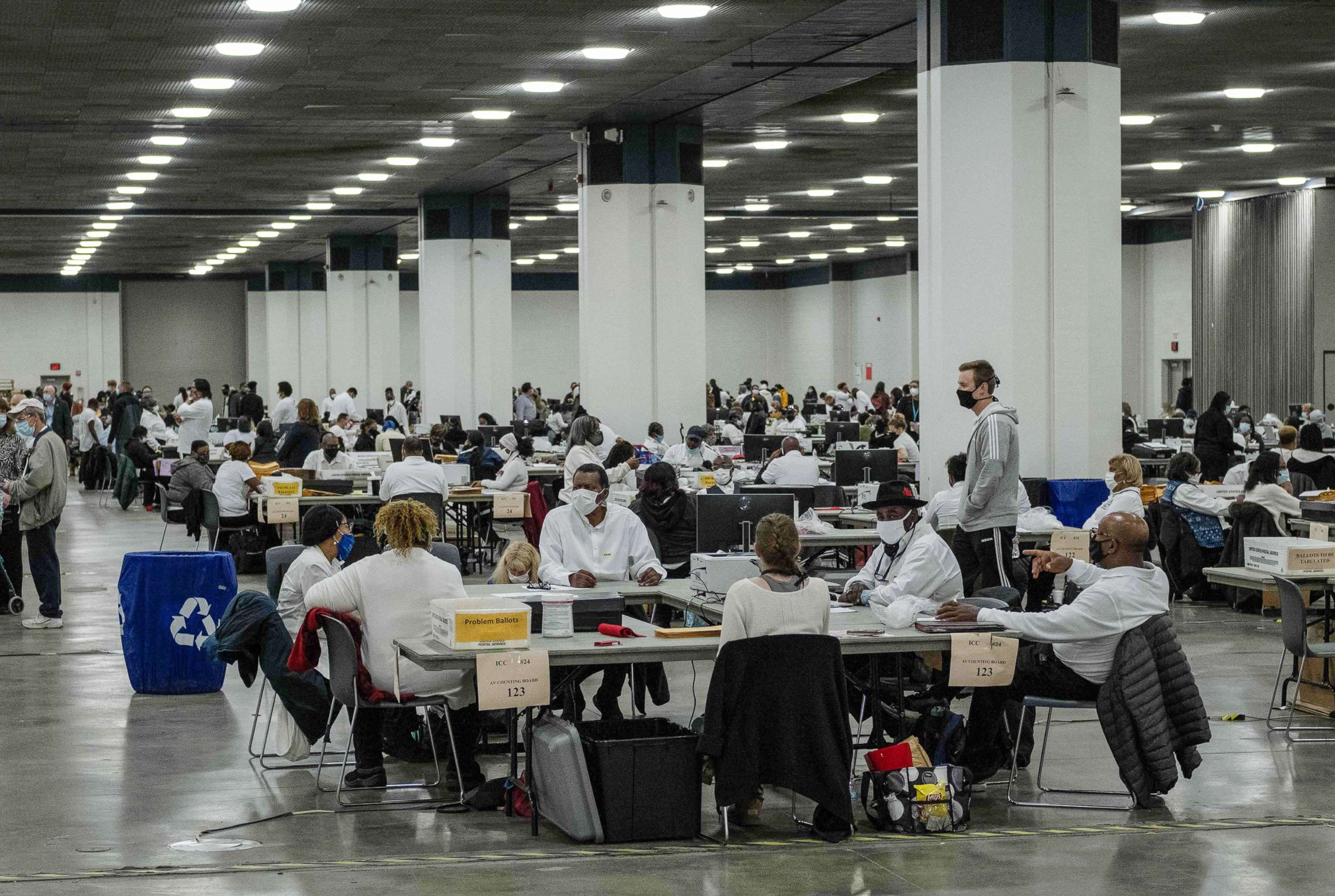Election 2020: Exit poll shows Biden gains in key groups, but with results awaiting the vote count
An unprecedented 64 percent of voters cast their ballots early.
The election that changed how Americans vote also changed the speed with which some of their votes are counted, leaving the country hanging for an official outcome even as former Vice President Joe Biden improved on Hillary Clinton’s performance nationally in a range of voting groups.
An unprecedented 64% of voters cast their ballots early, including 34% by mail – with those votes still being counted in several key states. Winners weren’t projected by the wee hours in states including Pennsylvania, Michigan, Wisconsin, Georgia and North Carolina.
Still, the national exit poll supported some broad conclusions. One was the still-growing share of racial and ethnic minorities in the electorate – 35%, up from 30% in 2016 and 10% when the first exit poll was produced in 1976. The diversity train rolled on.
Donald Trump improved in some gauges. Well fewer than half of voters, 44%, said he has the temperament to serve effectively as president – but that was up from 35% four years ago. And while 53% saw him unfavorably, that was down from 59% in 2016.
At the same time, the exit poll found Biden winning independents, often swing voters in national elections, by 14 percentage points, 54-40%; Trump won them by 6 points in 2016. Biden won moderates by 31 points in exit poll results, 64-33%; Hillary Clinton won them by 13 points.

Biden, further, won first-time voters by 34 points, vs. 20 for Clinton. Voters who’ve served in the military backed Trump by 7 points, down from his 24-point margin in this group in 2016. And, while a slighter difference, Biden was +3 points in the suburbs, vs. Trump’s +4 four years ago. And the gender gap narrowed considerably, but largely because Trump won men by 1 point, vs. 11 points four years ago.
Trump’s approval rating, 47-51%, approve-disapprove, was underwater, but mildly so. The only two presidents with negative approval at the time of their second election both lost – Jimmy Carter and George H.W. Bush – but both had much lower approval than Trump’s.
Trump and Biden fought essentially to a standstill on who’s better able to handle the economy, while Biden led, 51-43%, as better to handle the coronavirus pandemic. And voters by about the same margin, 51-42%, sided with Biden on stopping the spread of the virus as a priority, rather than with Trump on rebuilding the economy as a priority.
That’s even though 55% said the pandemic had caused them financial hardship; those who said so supported Biden by 30 points.
The public divided about evenly on whether the U.S. response to the pandemic has gone well or badly, with big state-to-state differences. At the same time, twice as many said it has gone very badly, 34%, as very well, 17%.
In a much larger disconnect for Trump, voters by 67-30% saw wearing a mask as a public health responsibility rather than a personal choice, with sharp vote differences between the two groups.
Among other results:
- 66% of voters called global warming a serious problem;
- 57% expressed a favorable opinion of the Black Lives Matter movement;
- 52% said the Supreme Court should uphold Obamacare, vs. 43% for overturning it; and
- 51% said abortion should be legal in all or most cases, a low in exit polls back to 1992.
Lastly, two results were heartening, perhaps, across partisan lines. Ninety-three percent said their state makes it somewhat or very easy to vote. And 87% were somewhat or very confident that their vote would be counted fairly. Eventually.
State exit poll findings in some key battlegrounds follow. Exit poll results in Arizona, Michigan and Pennsylvania were still preliminary, pending data adjustments.
Arizona
College-educated whites have gone for the Republican in Arizona presidential election exit polls since 2000 (as far back as the question was asked); this year they supported Biden, 55-44%. Trump, in turn, won non-college whites.
Independents outnumbered Republicans by 8 points and Democrats by 14 points. The growing share of independents (up from just 18% of voters 24 years ago) has shifted the state’s reputation as a Republican stronghold, despite its only having voted for a Democratic candidate for president once since 1952, in 1996. Biden lead among independents, 52-39%.
Maricopa County accounts for six in 10 Arizona voters; Biden held a scant 3-point edge there, 49-46%. Trump had a 5-point lead among suburban voters in the state overall.
Hispanic voters accounted for 19% of Arizona voters, compared with 15% in 2016 and 18% in 2012. They backed Biden by a 30-point margin, similar to his 34-point win among Hispanic voters nationally.
Florida
Republicans outnumber Democrats by 7 points in Florida exit poll results, 37% vs. 30%, the widest R-D margin in Florida exit poll data through 1988 and a shift from 2016’s 33-32%. Also, key to Trump’s victory was a 9-point lead among suburbanites, 54-45%, similar to his +10 in the Florida suburbs in 2016.
Adults 65 and older made up 31% of Florida voters, a new high, and an increase from 26% in 2016. Trump won them, 52 vs. 47%, but by a closer margin than in 2016, 17 points.
Non-Cuban Hispanics backed Biden 56-43%, tighter than their 71-26 Clinton-Trump vote in 2016. Cuban Americans voted 56-41% Trump-Biden, similar to four years ago.
Biden gained ground with moderates, 59-39%, but it wasn’t enough in a state where conservatives outnumbered liberals 38% to 20%.
Regionally, voters in the North/Panhandle divided 50-49% Trump; this group backed Trump by 20 points in 2016. Trump made it up with a closer margin in the Miami/Gold Coast region – just a 13-point Biden lead there, vs. Clinton’s +27.
Georgia
Georgia hasn’t gone for a Democratic presidential candidate since 1992. Hillary Clinton came within 5 points of winning the state in 2016; exit poll results showed Biden improving on that showing, albeit with votes yet to be counted.
Voters age 18 to 29 accounted for 21% of the electorate, up from 15% in 2016; they supported Biden 55-42%. College-educated whites moved from 69-28%, Trump-Clinton, in 2016, to 56-42%. And in the Atlanta suburbs, accounting for 28% of voters statewide, it was Biden +10, compared with Trump +6 in 2016.
As elsewhere, the pandemic loomed large. Half of the voters said it’s more important to contain the coronavirus than rebuild the economy; they supported Biden by a broad 82-17%. By contrast, 45% said it’s more important to rebuild the economy, and for them, the result was exactly reversed: 82% backed Trump, 17%, Biden.
Michigan
Trump won Michigan by 10,704 votes out of 4.8 million cast in 2016, the narrowest margin of any state that year and the first time a Republican presidential candidate carried the state since 1988. He was propelled by a 16-point margin among independents, an 11-point margin among suburbanites and by narrowing Obama’s 2012 margin among those in union households by 20 points. Updated exit poll results there now show Biden winning independents, 51-43%; Trump +2 in the suburbs, 48-50%, and a 56-41 Biden-Trump result among those in union households.

Biden’s improvements in these groups were countered by other shifts. Democrats outnumbered Republicans by 9 points in 2016, but the share among these groups was fairly even Tuesday, 37% Republicans and 36% Democrats. Voters in union households accounted for 22% of the Michigan electorate, compared with 28% in 2016. And 18- to 29-year-olds, a strong Biden group, accounted for 13% of voters, compared with 18% four years ago.
North Carolina
Trump hoped to recreate his narrow victory in North Carolina, which he won by 4 points over Hillary Clinton four years ago. Increased turnout among racial and ethnic minorities didn’t help; they accounted for 36% of North Carolina voters in exit poll results, up from 30% in 2016, and broke for Biden by a similar margin as then, 79-17%.
Biden also was aided by a blue shift among college-educated whites, who moved from +19 points for Trump four years ago to a 50-48% Trump-Biden split, the narrowest Republican margin in this group in exit polls since 1988.
Trump consolidated support among his core groups. Conservatives accounted for 39% of voters and backed Trump by a 79-point margin, up from 68 points in 2016. Trump also widened his margin among non-college whites, going from a 44-point win over Clinton to 56 points vs. Biden.
Pennsylvania
With 4 in 10 Pennsylvania voters casting their ballots early and state law forbidding counting before Election Day, the vote count in the state – which Trump won by less than a point in 2016 – wasn’t completed Tuesday.
Per the exit poll, it was close in the suburbs, 50-48%, Trump-Biden, with women leaning toward Biden and men toward Trump. Trump maintained the wide win among non-college white men that he had in 2016, now 72-27%, but split those with degrees, 49 percent to Biden’s 49%.
Voters prioritized containing the coronavirus, 54 percent, over rebuilding the economy, 43%, and more thought that Biden could handle the pandemic better than Trump, 54-43%. But economics still mattered: Forty-seven percent said they experienced COVID-19-related financial hardships and 38% picked the economy as the issue that mattered the most to them in their vote (the plurality choice out of five presented). As nationally, there was a split on who could handle the economy better, 50-48%, Trump-Biden.
Wisconsin
With a raging pandemic and the third-highest per-capita case count in the nation, 53% of Wisconsin voters said U.S. efforts to contain the pandemic are going badly. By a 52-44% margin, Wisconsinites said Biden would do a better job dealing with the pandemic than Trump. The candidates were rated more closely on handling the economy, 49-48%, Trump-Biden.
As in 2016, Trump won non-college white men – but his 27-point, 62-35% result in updated data was down from a 43-point margin four years ago. The margin among college-educated white men, 51-48 Biden-Trump, is similar to the split seen in 2016.
It was 55-43%, Trump-Biden, in the suburbs, tightening to a virtually even 50-49% among suburban women. Four years ago Trump was 29 points underwater in favorability yet won the state (by fewer than 23,000 votes). This year, his favorability was slightly better – 43-56%, favorable-unfavorable. In Biden’s case, it was 51-48%, better than Clinton’s 42-56% in 2016.
Analysis by Gary Langer, Christine Filer, Sofi Sinozich, Allison De Jong, Steven Sparks, Laura Silver and Patrick Moynihan.



